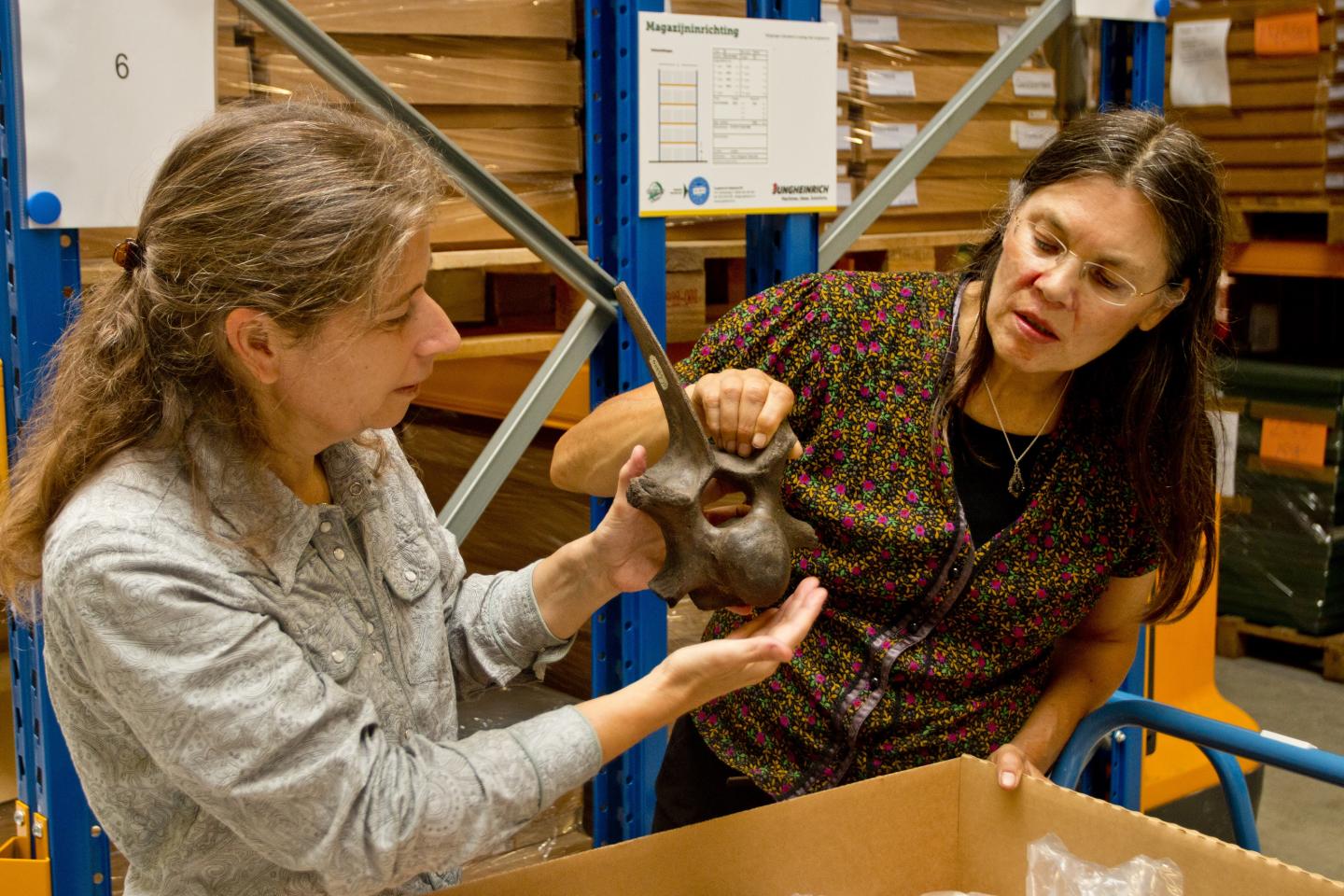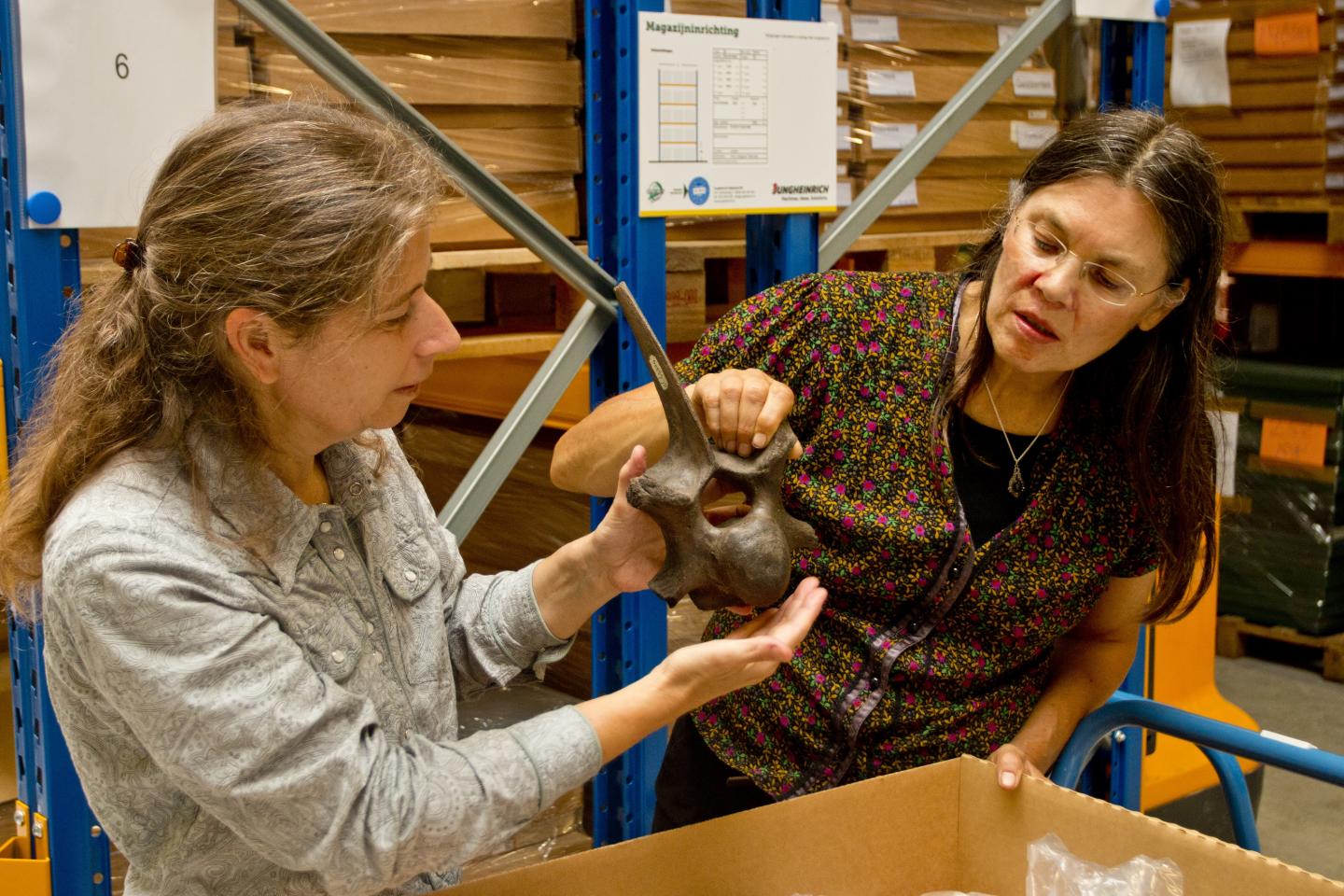
Credit: Jacques van Alphen
Researchers from the Naturalis Biodiversity Center in Leiden examined woolly rhino and modern rhino neck vertebrae from several European and American museum collections and noticed that the remains of woolly rhinos from the North Sea often possess a 'cervical' (neck) rib — in contrast to modern rhinos.
The study, published in the open access journal PeerJ today, reports on the incidence of abnormal cervical vertebrae in woolly rhinos, which strongly suggests a vulnerable condition in the species. Given the considerable birth defects that are associated with this condition, the researchers argue it is very possible that developmental abnormalities contributed towards the eventual extinction of these late Pleistocene rhinos.
In modern animals, the presence of a 'cervical rib' (a rib attached to a cervical vertebra) is an unusual event, and is cause for further investigation. Though the rib itself is relatively harmless, this condition is often associated with inbreeding and adverse environmental conditions during pregnancy.
Frietson Galis, one of the authors of the peer-reviewed study, found a remarkably high percentage of these neck ribs in the woolly mammoth, published in a previous study.
"This aroused our curiosity to also check the woolly rhino, a species that, like the woolly mammoth lived during the late Pleistocene and similarly died out", said Alexandra van der Geer, one of the authors of the study. "The woolly rhino bones were all dredged from the North Sea and river deltas in the Netherlands. We knew these were just about the last rhinos living there, so we suspected something could be wrong here as well. Our work now shows that there was indeed a problem in the woolly rhino population".
The absence of cervical ribs in the modern sample is by no means evidence that rhino populations today are healthy. Museum collections are based on rhino specimens that were collected at least five decades ago. Rhinoceros numbers are dwindling extremely fast, especially the last two decades, resulting in near extinction for some species and the total extinction of the western black rhinoceros.
"Our study suggests that monitoring the health of the vertebrae in rhinos has the potential to timely detect developmental errors that indicate the level of extinction risk", said Frietson Galis.
###
Images:
Image 1: Evidence of cervical ribs from a woolly rhino
Caption: Arrows indicate large articulation facets of cervical ribs on a fossil cervical vertebra of a woolly rhino of Naturalis, Leiden.
Photo: Frietson Galis.
Image 2: Authors Alexandra van der Geer (left) and Frietson Galis (right) investigating a vertebra of a woolly rhino. Photo: Jacques van Alphen
Licence for photo use: copyright Naturalis. This photograph may freely be used in print and electronic publications about this PeerJ study, provided that proper attribution to the photographers is made.
Full Media Pack including image: https://drive.google.com/open?id=0BzGrFBtalE6wVWhnZ0lHZVF6X1U
PDF of this Press Release: http://static.peerj.com/pressReleases/2017/08/Press-Release-van-der-Geer.pdf
Link to the Published Version of the article (quote this link in your story – the link will ONLY work after the embargo lifts): https://peerj.com/articles/3684 your readers will be able to freely access this article at this URL.
Citation to the article: van der Geer and Galis (2017), High incidence of cervical ribs indicates vulnerable condition in Late Pleistocene woolly rhinoceroses. PeerJ 5:e3684; DOI 10.7717/peerj.3684
About:
PeerJ is an Open Access publisher of two peer-reviewed journals and a preprint server. PeerJ is based in San Diego, CA and the UK and can be accessed at https://peerj.com/. PeerJ's mission is to help the world efficiently publish its knowledge.
All works published in PeerJ are Open Access and published using a Creative Commons license (CC-BY 4.0). Everything is immediately available — to read, download, redistribute, include in databases and otherwise use — without cost to anyone, anywhere, subject only to the condition that the original authors and source are properly attributed.
PeerJ has an Editorial Board of over 1,600 respected academics, including 5 Nobel Laureates. PeerJ was the recipient of the 2013 ALPSP Award for Publishing Innovation. PeerJ Media Resources (including logos) can be found at: https://peerj.com/about/press/
Media Contacts
For the authors:
Alexandra van der Geer
[email protected]
Frietson Galis
[email protected]
Phone: +31648814360
For PeerJ: email: [email protected] , https://peerj.com/about/press/
Note: If you would like to join the PeerJ Press Release list, please register at: http://bit.ly/PressList
Media Contact
Alexandra van der Geer
[email protected]
31-648-814-360
@ThePeerJ
http://https://peerj.com
Original Source
http://static.peerj.com/pressReleases/2017/08/Press-Release-van-der-Geer.pdf http://dx.doi.org/10.7717/peerj.3684





